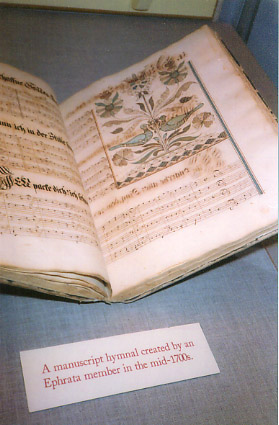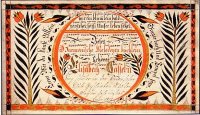 The popular practice of illustrating hymnals, copy books and religious texts is the most valid argument for the notion that fraktur is a revival, if not a surviving example, of medieval book illumination (Shelley, p. 22). While the general proposition is very tenuous, the beautiful work of the Ephrata Cloister is certainly close to the monastic tradition. As early as 1745, the brothers and sisters of the Cloister meticulously illustrated pages in a distinctive pale, fluid style. To complete the picture, they worked in the Cloister scriptorium.
The popular practice of illustrating hymnals, copy books and religious texts is the most valid argument for the notion that fraktur is a revival, if not a surviving example, of medieval book illumination (Shelley, p. 22). While the general proposition is very tenuous, the beautiful work of the Ephrata Cloister is certainly close to the monastic tradition. As early as 1745, the brothers and sisters of the Cloister meticulously illustrated pages in a distinctive pale, fluid style. To complete the picture, they worked in the Cloister scriptorium.
 Beginning later in the eighteenth century, and especially from the 1780’s to the 1830’s, marking book ownership with hand drawn fraktur pages reached a zenith, especially among the sectarian groups, Mennonites and Schwenkfelders. This genre shows meticulous attention to detail and balance and, as can be seen in the Samuel Godshall (Mennonite) piece to the right, often shows great originality and beauty. Illustrated songbooks and religious texts were often given to children.
Beginning later in the eighteenth century, and especially from the 1780’s to the 1830’s, marking book ownership with hand drawn fraktur pages reached a zenith, especially among the sectarian groups, Mennonites and Schwenkfelders. This genre shows meticulous attention to detail and balance and, as can be seen in the Samuel Godshall (Mennonite) piece to the right, often shows great originality and beauty. Illustrated songbooks and religious texts were often given to children.
813 thoughts on “Bookplate Fraktur”
Comments are closed.